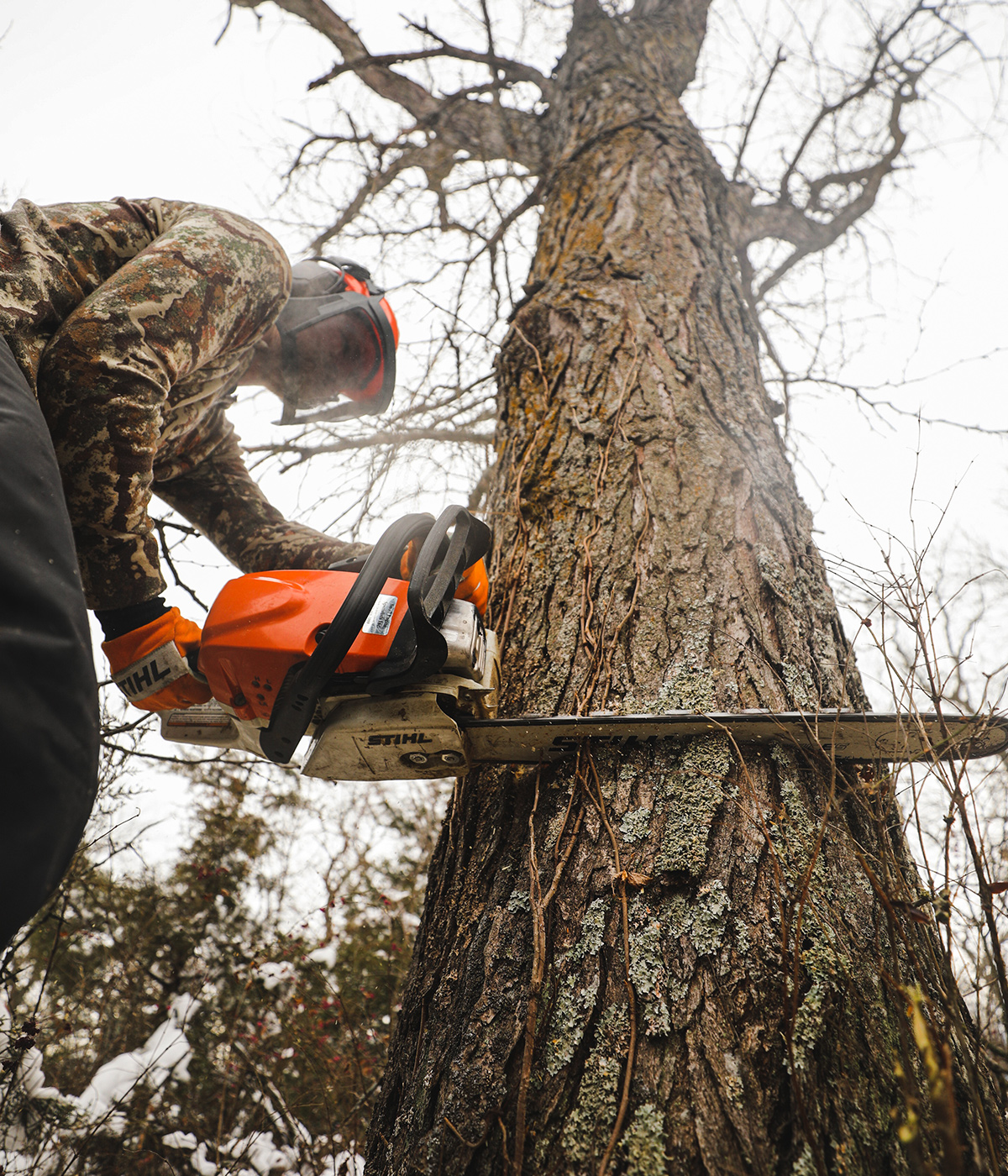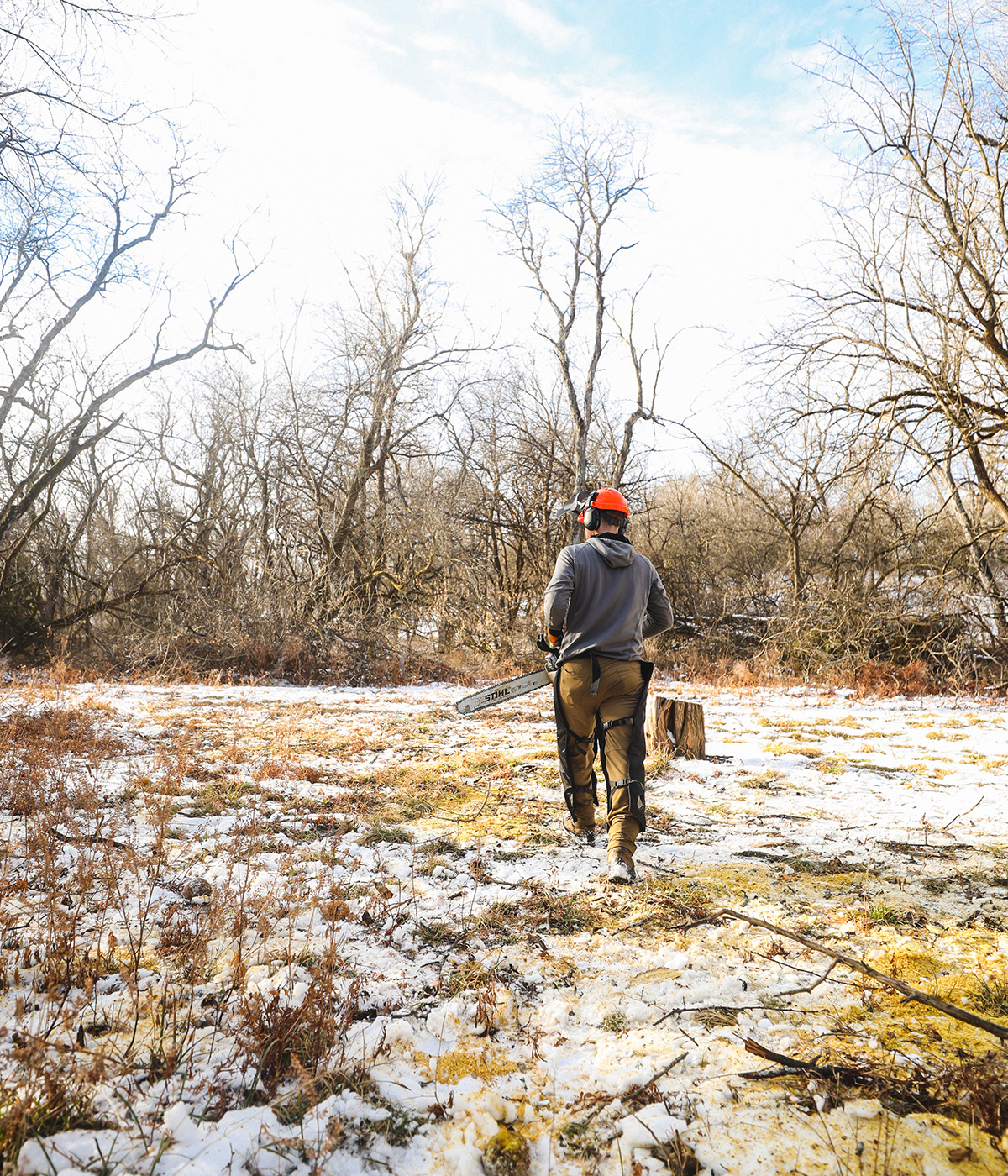While food plots are a relatively easy and important benefit to improving whitetail habitat on your property, don’t overlook the benefits of managing timber for producing bigger, healthier whitetail bucks. From timber stand improvement (TSI) best practices to select cutting and creating savanna habitat, there’s a lot of potential balancing in the branches on your land.
We connected with co-owner and operator of Land & Legacy Matt Dye to discuss some dos, don’ts, and big picture thinking when it comes to TSI and managing land for whitetails.
TSI Defined and Getting Started
TSI can mean drastically different things depending on whether you’re cutting for profit or cutting for habitat. The U.S. Forest Service defines TSI like this: “Timber stand improvement (TSI) includes activities or treatments that improve the composition, structure, condition, health, and growth of even-age or uneven-age stands. Such activities may include mechanical or chemical treatment of vegetation that competes with desirable trees; removing diseased or dying trees; thinning; pruning; and post-harvest treatments on natural regenerating stands.”
Before starting any TSI project, it’s important to understand a few key factors. “Number one is future timber value,” says Dye. “What are you trying to accomplish by thinning? What trees are marketable in certain stands you’re trying to improve upon?
“Number two, I would try to think about what is your goal relative to timber versus relative to wildlife. You could look at a tree, perhaps it’s a hickory, but deer aren’t eating hickory nuts though there’s some financial value to leaving that tree. At the same time, you might be stuck between a rock and hard place because which is more important to you when you go out and do this TSI practice?
“As a land manager, you need to be thinking about 10 years-plus and through to the next generation because what you do now affects everyone in the future. We need to be thinking of the future when we’re developing a plan. However, when you’re implementing, and this is where most people get it wrong, you need to be focused on what you need to be doing that specific year. Once you develop a plan, focus on the task at hand. If you need to course-correct that can be done, but most people don’t seem to have a concrete plan initially and they’re waffling back and forth with ‘Should I do this? Or I could do that there? Maybe I should cut more, or cut less? I don’t know what to do.’ It’s because they never started with a plan.”
If you’re logging for profit you’ll be cutting many of the biggest and best trees on your property, likely those mature, old oaks that have been producing acorns for decades. With the most mature oaks gone, you might be left with only low whitetail-value mature trees, like buckeyes, gums, maples, and other tree species that don’t provide forage for whitetail deer. In this cut-and-dry example, it’s clear to see how cutting for profitable boards-per-foot and cutting for deer improvement may differ.
But it’s not necessary to have one or the other. It’s about finding the right balance, and the balancing act starts with leaving behind some number of mast-producing trees and select-harvesting others while also leaving behind some younger trees to mature.

Managing Timber for Whitetail Deer
As noted, managing timber for its financial value may not always align best with managing for wildlife, but if your goal is to manage timber stands for whitetails and other wildlife a little cutting can go a long way.
“The worst thing possible to do on your property is to do nothing,” says Dye. “Timber management is not a passive thing. It’s an active thing. If you’re trying to improve a property, we can’t sit back and sit on our hands. We have to be doing something and manipulating, diversifying, or cutting trees.
“There’s a combination where you can cut too much and open up to the ground floor. If you cut to only leave 30% of the canopy intact, your end result is going to be more herbaceous and grassy because you have so much sunlight coming in.
“For whitetails, specifically, we’re talking about TSI to add good quality bedding cover or comfort cover, so you’re probably not wanting to go that hard in a lot of areas. Less canopy is good for feeding locations or travel corridors, but if we’re trying to add cover on the ground we’re probably going to want to do, from a TSI standpoint, a 30-50% canopy reduction and you leave 70-50% of the canopy intact. With this, you’ll get a great response, generally, if it’s more hardwood stems and bramble, which is a lot of deer food, as well as good cover. That’s all based on the amount of sunlight you’re letting back into the system. The more sunlight you let in the more grasses you’ll get, but with about a 50/50 mix you get a happy medium, and you’re going to hit what you need to do for whitetails in terms of overall forage and cover.”

Why Monoculture Misses the Mark
It can be said that too much of a good thing is not good. This is especially true with quality deer habitat. While it might make land management easier, only focusing on land practices that produce one or two good things, such as bedding, food plots, or closed-canopy forest, will not keep whitetails on the property year-round. Diversity is a must.
“Most importantly,” says Dye, “monocultures are not natural. Rarely do you ever see in a natural, functional environment a monoculture. That’s a manmade thing. This goes back to managing your timber or managing your property for wildlife.
“Can wildlife use a monoculture? Certainly, at some times during the year it may provide something, but we don’t need acres and acres and acres. The monoculture mindset, and we’ll use oak trees as an example, is thinking that oak trees are the best and you’re going to cut every tree except the oak trees. That’s not good; that’s not a functional ecosystem. Those trees are going to age out and die and then what do you have left? You have to have multiple species, and specifically related to timber, you have to have multiple ages of trees. You should have some old-growth forest, and some middle-aged forest, and you should absolutely have some young forest on your property. All those ages and species create diversity and gets you far, far away from monoculture.”
How Much Land Do We Need for TSI?
“When I think of the practice of the technique of TSI, we’re talking five-acre units and up. If you’re under five acres, you’re only to get a certain amount of sunlight in there.” – Matt Dye
“From a timber industry standpoint, select cutting is an uneven age regeneration process, as opposed to clear-cutting, which is an even age regeneration process.” – Matt Dye
“Don’t be afraid to start small. Determine where the low-hanging fruit is on the property and do what you’re comfortable with. The tools of TSI can be everything from a small hatchet up to a full timber harvest.” – Matt Dye
Header Image: Heartland Bowhunter